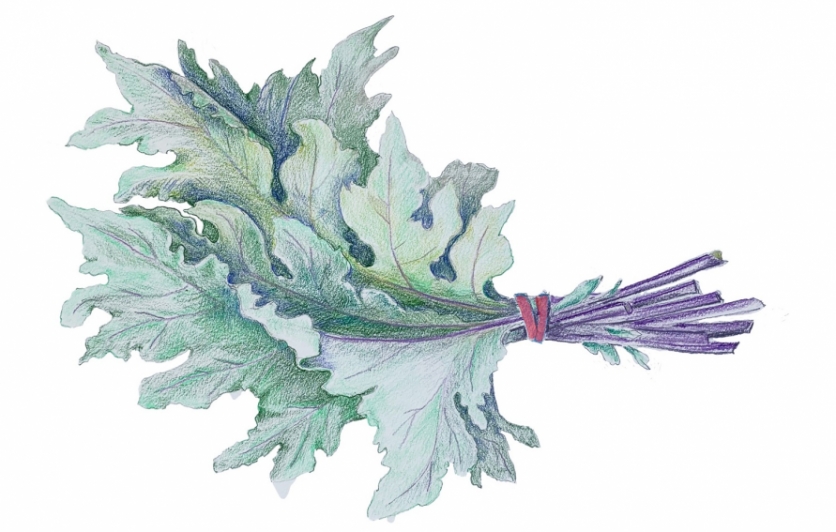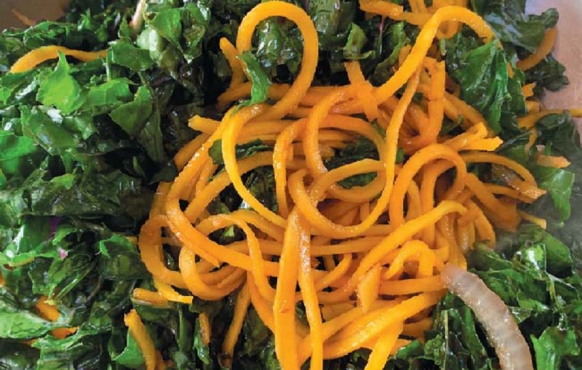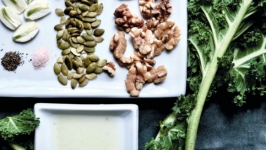Courting Kale

While kale may have surged in popularity in the last few decades, it has been a dependable food source for both humans and livestock around the world for centuries. Kale is believed to be one of the earliest domesticated forms of wild cabbage. Native to Europe and Asia, there are dozens of colorful varieties to choose from and it packs a nutritional punch that is hard to beat.
Poetic Justice
Kale (sometimes spelled kail) was so dependable and common a few hundred years back that kitchen gardens in Scotland were referred to as kailyards. It was an important staple of a Scotsman’s diet along with oats and grain. Because of its cold-hardiness, it could be harvested November through June, providing important nutrition in otherwise lean months.
The word kailyard is also used to define a type of fiction popular in Scotland during the late 1800s. With titles such as Beside the Bonnie Briar Bush by Ian Maclaren, it presented a rose-colored view of history while the country, at the time, was experiencing thorny industrial upheaval. Some embraced this bucolic fiction while others felt compelled to criticize the unrealistic picture painted by the authors. My appreciation for country life, along with my passion for growing and eating kale, leads me to favor these writers. Why not put this practical brassica on a pedestal and toss it a poem or two?
Boiling Over
I have to think that kale fell out of favor for a time because the most common way to prepare it was to boil it. Boiling not only releases the sulfur compounds that smell like old eggs to some, but it doesn’t allow kale’s flavors to shine. People have since discovered many ways to enjoy this versatile veggie, including smoothies, chips, casseroles and even muffins or cookies. Jennifer Iserloh, co-author and chef of the quirky book Fifty Shades of Kale (written with Drew Ramsey, MD), recommends that you sear kale like you might sear meat, because the heat caramelizes the sugar in the leaves and brings out its sweetness. The book also features other fun dishes such as Kale and Black Cherry Sorbet.
Got Kale?
Once you find your favorite way to prepare kale you can congratulate yourself on providing your body with a bunch of health benefits as well. The dark leafy greens in the brassica family are a great source of calcium. The Nutrition Source, from Harvard’s T.H. Chan School of Public Health, explains that your body can absorb calcium more easily from leafy greens than from dairy products, so one cup of greens will provide as much usable calcium as a cup of milk. Calcium is important for bone health, and it is also important for helping to build muscle health, improving blood clotting and regulating heart rhythms.
Pretty in Pink
Kale grows in a variety of hues from deep reds and greens to frilly leaves of white, grey or pink. “Ornamental” kale is best known for dynamic garden accents, but all varieties are perfectly edible from leaf to flower. Varieties such as Yokohama and Kamome work as well on a platter as in the garden plot. However, some varieties bred for their appearance might be less tasty. Local kale reaches its peak color in the fall and is most delicious after the first frost. The cold transforms starches in the cell walls into sugars, enhancing the sweetness in the leaves.
Kale can easily take center stage as wedding decorations, or it can simply add some flair to everyday bouquets. Corrine Lasek, owner and designer of Hyacinth House Curiosities and Floral Boutique in Buffalo, appreciates the versatility of kale and finds it gives a bouquet a natural feel. She says that when you add something edible and familiar, it makes people say, “Someone really grew this!” It is a connection many people don’t readily make with exotic flowers shipped from far away.
Start Fresh
In my opinion, kale is best enjoyed fresh if it is prepared well. “Kale Caesar” is a favorite in my house for busy nights when you want to make a super satisfying salad quickly. There are many versions of this, including recipes with homemade dressings and grilled chicken, but my version uses items readily available in my pantry plus a prepared dressing. I have used Caesar, lemon poppyseed, and honey mustard dressings with good results.
Begin by washing your kale, trimming the ribs and shredding. I like to fold each kale leaf in half to rip the rib out. Next, stack the leaves, roll them like a cigar and slice crosswise (chiffonade). Then do a few more slices lengthwise until you have pieces that range from dime- to quarter-size. In a large bowl, sprinkle the shredded kale with about 2 tablespoons of lemon juice and ½ teaspoon of salt per pound of kale. Using your hands, gently massage the kale for about 3–5 minutes, distributing the salt and lemon throughout. Massaging in this way tenderizes the leaves and brings out a bit of sweetness. Let the kale sit for a few minutes then add a handful each of dried cranberries and walnuts. Mix in your favorite dressing and you are ready to go.









